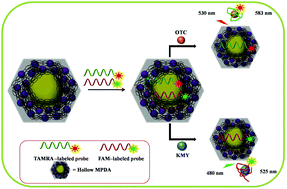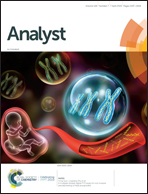A novel fluorescent sensing platform based on metal-polydopamine frameworks for the dual detection of kanamycin and oxytetracycline
Abstract
In this study, we report the dual detection of kanamycin (KMY) and oxytetracycline (OTC) using metal polydopamine frameworks (MPDA) for the first time. This sensing system employed metal polydopamine frameworks (MPDA), which acted as a fluorescence quencher in the interaction between MPDA and dye-labeled DNA molecules; the metal polydopamine frameworks exhibited an excellent fluorescence quenching behaviour and good analytical response towards the detection of the biomolecules KMY and OTC. The accumulated kanamycin and oxytetracycline in the sensing system were recovered, and changes in their fluorescence intensity were monitored at 525 and 583 nm. Under the optimal conditions, the proposed sensing system remarkably achieved highly sensitive and selective detection of KMY and OTC with the limit of detection of 304 pM and 481 pM, respectively. In addition, the selectivity of the developed sensor was explored in the presence of competitive biomolecules. Moreover, this sensing system demonstrated great potential and versatility for the rapid detection of molecules. In addition, this biosensor was successfully evaluated for the dual detection of KMY and OTC in different real samples.

- This article is part of the themed collection: Optical Biosensor Devices


 Please wait while we load your content...
Please wait while we load your content...